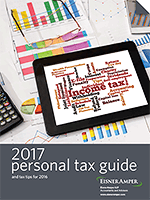
2017 Personal Tax Guide
- Published
- Jan 31, 2017
- By
- Marie Arrigo
- Topics
- Share

Introduction: 2017 Poised for Tax Law Changes
As we begin a new year, we find the higher tax regime resulting from the passage of the American Taxpayer Relief Act of 2012 (“ATRA”) continues into 2017. The top federal ordinary income tax rate is at 39.6%, while the top federal long-term capital gains rate is at 20%. The top alternative minimum tax remains at 28%. The top estate and gift tax rate remains at 40% and a $5.49 million gift, estate, and generation-skipping tax exclusion (as adjusted for inflation) is in effect.
The enactment of the Protecting Americans from Tax Hikes Act of 2015 (“PATH”) extended many of the tax incentives and credits for businesses and individuals, some on a permanent basis. The Patient Protection and Affordable Care Act (“ACA”) continues to impose a 0.9% Health Insurance Tax on earned income for higher income individuals and a 3.8% Medicare Contribution Tax on net investment income. The tax is imposed on the lesser of (a) net investment income, such as interest income, dividends, capital gains and passive income less expenses directly attributable to the production of such income and (b) the excess of modified adjusted gross income over a specified dollar amount ($250,000 for joint filers or a surviving spouse, $125,000 for married filing separately and $200,000 for other taxpayers).
That being said, the election of Donald J. Trump as the 45th president of the United States appears to make tax reform likely in 2017. During the 2016 presidential campaign, tax-related proposals included the following: lower and consolidated individual income tax rates, a cap on itemized deductions, elimination of the personal exemptions and head of household filing status, expansion of tax breaks for families, repeal of the alternative minimum tax, repeal of the Affordable Care Act and elimination of the 3.8% net investment income tax, ordinary income tax treatment of carried interest, reduction of the corporate income tax rate and elimination of the corporate alternative minimum tax, 15% flat rate on pass-through income retained within a business, and repeal of the estate and gift tax. It is also important to note that these proposals may change now that President Trump has assumed office. The new administration and the GOP-controlled Congress might move quickly with a package of tax cuts before the summer. We will certainly keep you updated on any new tax reform legislation that is presented.
At the same time, legislation, court decisions and IRS regulations issued in 2016 will impact 2017 and beyond. Here are some of the highlights:
- In March 2016, President Obama signed the Trade Facilitation and Trade Enforcement Act of 2015, which included an increase in the penalty for failure to file a return for returns required to be filed in calendar years after 2015.
- In August 2016, the IRS issued proposed regulations changing the estate tax valuation regime under IRC section 2704. The proposed regulations addressed certain abuses relating to the valuation of interests of corporations and partnerships for estate, gift, and generation-skipping transfer tax purposes with the treatment of lapsing rights and restrictions on liquidation when determining value in intra-family transfers.
- In September 2016, the IRS issued final regulations explaining that marriage for federal tax purposes encompasses both opposite sex and same-sex marriages. The proposed regulations follow the Supreme Court’s decision on same-sex marriage in Obergefell.
- In October 2016, the IRS issued final debt-equity IRC section 385 regulations, which establish threshold documentation requirements that must be satisfied for certain related-party interests in a corporation to be treated as debt, and treat as stock certain related-party instruments that normally would be considered debt. While the final regulations tone down the reach of earlier regulations, there is still concern over the broad potential for debt/equity reclassification.
- In December 2016, President Obama signed the 21st Century Cures Act, allowing certain small businesses to use qualified small business health reimbursement arrangements without having imposed penalties for failure to satisfy market reforms under the ACA.
- Congress did not take up before the end of 2016 the extenders which expired at December 31, 2016. These extenders related to energy, higher education tuition and fees deduction, mortgage debt forgiveness tax relief and private mortgage insurance deductibility. These extenders may become part of tax reform legislation in 2017.
- The Surface Transportation and Veterans Health Care Choice Improvement Act of 2015 changed the filing due dates of many tax returns, effective for the 2016 tax returns due in 2017. We have included in our guide a new Appendix E, which highlights these new changes.
- The Surface Transportation and Veterans Health Care Choice Improvement Act of 2015 also mandated reporting to assure that a beneficiary’s basis in certain property acquired from a decedent be consistent with the value of the property for estate tax purposes. Because executors were not prepared to comply with this requirement, the IRS had issued several extensions of the initial filing. Final regulations confirmed that no further extensions beyond June 30, 2016 would apply to the initial reporting and that the rule going forward requires reporting within 30 days of filing Form 706.
The international arena still continues to be of concern to many individuals and families. The global threat of terrorism, the confrontation with Russia over hacking U.S. systems and the Ukraine, BREXIT and the EU, and perennial hot spots such as North Korea, China’s economic slowdown, the Panama Papers, inversions and global M&A continue to be significant issues.
Many families with wealth are concerned about their children’s and grandchildren’s future, and wonder what can be done to sustain and grow their wealth in these uncertain times. With the many law changes cited above, the likelihood of new tax reform legislation and the current economic and geopolitical conditions, it is extremely important that you pay attention to your financial position so that you can achieve your financial goals. Specific items such as retirement planning, managing cash flow, financing the cost of your children’s college education and transferring your family’s wealth to the next generation should be top-of-mind in 2017. Indeed, 2017 will most certainly be a pivotal year for taxes and tax planning.
We have written this guide to provide you with a tool to identify opportunities to minimize tax exposure, accomplish your financial goals, and preserve your family’s wealth. The guide includes all major law changes through January 1, 2017. The best way to use this guide is to identify areas that may be most pertinent to your unique situation and then discuss the matter with your tax advisor. As always, our tax professionals will be pleased to discuss any of the ideas in this guide or any other planning opportunities which might apply to your personal situation.
This guide is meant not only to assist with the preparation of your 2016 income tax returns, but also to plan for 2017 and beyond. Because of the real possibility that tax reform impacting 2017 may be enacted after the publication of this guide, please be sure to check in with us before proceeding with any tax planning transactions.
|
|
| 2017 Personal Tax Guide complete download [Adobe PDF file] | |
| chapter | Table of Contents– download by chapter |
| 1 | Tax Planning Strategies |
| 2 | Tax Rate Overview |
| 3 | Estimated Tax Requirements |
| 4 | Alternative Minimum Tax |
| 5 | Business Owner Issues and Depreciation Deductions |
| 6 | Capital Gains and Dividend Income |
| 7 | Stock Options, Restricted Stock and Deferred Compensation |
| 8 | Small Business Stock |
| 9 | Passive and Real Estate Activities |
| 10 | Principal Residence Sale and Rental |
| 11 | Charitable Contributions |
| 12 | Interest Expense |
| 13 | Retirement Plans |
| 14 | Estate and Gift Tax Planning |
| 15 | Tax Credits |
| 16 | Education Incentives |
| 17 | International Tax Planning and Reporting Requirements |
| 18 | State Tax Issues |
| Appendices | |
| Appendix A | 2017 Federal Tax Calendar for Individual Taxpayers |
| Appendix B | 2016 Federal Tax Rate Schedule |
| Appendix C | 2017 Federal Tax Rate Schedule |
| Appendix D | 2016 and 2017 Maximum Effective Rates |
Editor-in-Chief
Marie Arrigo
Co-Editors
Gary Bingel, Angela Chen, Denise DeLisser, Carolyn Dolci, Dan Gibson, Stephanie Hines, Robert Levin, Peter Michaelson, Tom Hall
Contributors
Jonathan Acquavella, June Albert, Peter Alwardt, Benjamin Aspir, Paul Bleeg, Lina Chan, Cindy Feder, Susan Fludgate, William Gentilesco, Nancy Gianco, Matthew Halperin, Kety Hernandez, Cindy Huang, Sue Huang, Jean Jiang, Bo Kearney, Seth Komitzky, Cindy Lai, Kevin Sohr, Jeanne Marie Waldman, Holly Wong
This tax guide highlights tax planning ideas that may help you minimize your tax liability. This guide does not constitute accounting, tax, or legal advice, nor is it intended to convey a thorough treatment of the subject matter. The best way to use this guide is to identify those issues which could impact you, your family, or your business and then discuss them with your tax advisor.
The discussion in this guide is based on the Internal Revenue Code as amended through January 1, 2017. Future legislation, administrative interpretations, and judicial decisions may change the advisability of any course of action. Because of periodic legislation changes, you should always check with your tax advisor before implementing any tax planning ideas.
Any tax advice contained in this publication (including any attach¬ments) is not intended for and cannot be used for the purpose of (i) avoiding penalties imposed by the Internal Revenue Code or (ii) promoting, marketing, or recommending any transaction or matter addressed herein.
Copyright 2017 by EisnerAmper. All rights reserved. This book, or portions thereof, may not be reproduced in any form without permission of EisnerAmper.
What's on Your Mind?
Start a conversation with Marie
Receive the latest business insights, analysis, and perspectives from EisnerAmper professionals.













